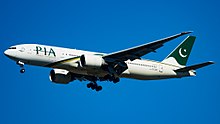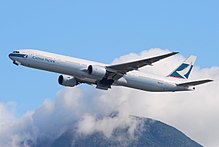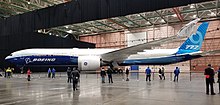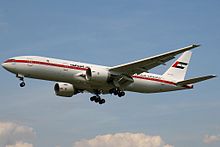777-200LR
The 777 can accommodate a ten–abreast seating layout and has a typical 3-class capacity of 301 to 368 passengers, with a range of 5,240 to 8,555 nautical miles [nmi] (9,700 to 15,840 km; 6,030 to 9,840 mi). The jetliner is recognizable for its large-diameter turbofan engines, raked wingtips, six wheels on each main landing gear, fully circular fuselage cross-section, and a blade-shaped tail cone. The 777 became the first Boeing airliner to use fly-by-wire controls and to apply a carbon composite structure in the tailplanes.
The original 777 with a maximum takeoff weight (MTOW) of 545,000–660,000 lb (247–299 t) was produced in two fuselage lengths: the initial 777-200 was followed by the extended-range -200ER in 1997; and the 33.25 ft (10.13 m) longer 777-300 in 1998. These have since been known as 777 Classics and were powered by 77,200–98,000 lbf (343–436 kN) General Electric GE90, Pratt & Whitney PW4000, or Rolls-Royce Trent 800 engines. The extended-range 777-300ER, with a MTOW of 700,000–775,000 lb (318–352 t), entered service in 2004, the longer-range 777-200LR in 2006, and the 777F freighter in 2009. These second-generation 777 variants have extended raked wingtips and are powered exclusively by 110,000–115,300 lbf (489–513 kN) GE90 engines. In November 2013, Boeing announced the development of the third generation 777X (variants include the 777-8, 777-9, and 777-8F), featuring composite wings with folding wingtips and General Electric GE9X engines, and slated for first deliveries in 2026.
As of 2018, Emirates was the largest operator with a fleet of 163 aircraft. As of November 2024, more than 60 customers have placed orders for 2,302 Triple Sevens across all variants, of which 1,740 have been delivered. This makes the 777 the best-selling wide-body airliner, while its best-selling variant is the 777-300ER with 831 delivered. The airliner initially competed with the Airbus A340 and McDonnell Douglas MD-11; since 2015 it has mainly competed with the Airbus A350. First-generation 777-200 variants are to be supplanted by Boeing's 787 Dreamliner. As of May 2024, the 777 has been involved in 31 aviation accidents and incidents, including five hull loss accidents out of eight total hull losses with 542 fatalities including 3 ground casualties.
Development
Background

In the early 1970s, the Boeing 747, McDonnell Douglas DC-10, and the Lockheed L-1011 TriStar became the first generation of wide-body passenger airliners to enter service. In 1978, Boeing unveiled three new models: the twin-engine or twinjet Boeing 7N7 (later named Boeing 757) to replace its 727, the twinjet Boeing 7X7 (later named 767 to challenge the Airbus A300, and a trijet "777" concept to compete with the DC-10 and L-1011. The mid-size 757 and 767 launched to market success, due in part to 1980s' extended-range twin-engine operational performance standards (ETOPS) regulations governing transoceanic twinjet operations. These regulations allowed twin-engine airliners to make ocean crossings at up to three hours' distance from emergency diversionary airports. Under ETOPS rules, airlines began operating the 767 on long-distance overseas routes that did not require the capacity of larger airliners. The trijet "777" was later dropped, following marketing studies that favored the 757 and 767 variants. Boeing was left with a size and range gap in its product line between the 767-300ER and the 747-400.
By the late 1980s, DC-10 and L-1011 models were expected to be retired in the next decade, prompting manufacturers to develop replacement designs. McDonnell Douglas was working on the MD-11, a stretched successor of the DC-10, while Airbus was developing its A330 and A340 series. In 1986, Boeing unveiled proposals for an enlarged 767, tentatively named 767-X, to target the replacement market for first-generation wide-bodies such as the DC-10, and to complement existing 767 and 747 models in the company lineup. The initial proposal featured a longer fuselage and larger wings than the existing 767, along with winglets. Later plans expanded the fuselage cross-section but retained the existing 767 flight deck, nose, and other elements. However, airline customers were uninterested in the 767-X proposals, and instead wanted an even wider fuselage cross-section, fully flexible interior configurations, short- to intercontinental-range capability, and an operating cost lower than that of any 767 stretch.
Airline planners' requirements for larger aircraft had become increasingly specific, adding to the heightened competition among aircraft manufacturers. By 1988, Boeing realized that the only answer was a clean-sheet design, which became the twinjet 777. The company opted for the twin-engine configuration given past design successes, projected engine developments, and reduced-cost benefits. On December 8, 1989, Boeing began issuing offers to airlines for the 777.
Design effort

Alan Mulally served as the Boeing 777 program's director of engineering, and then was promoted in September 1992 to lead it as vice-president and general manager. The design phase of the all-new twinjet was different from Boeing's previous jetliners, in which eight major airlines (All Nippon Airways, American Airlines, British Airways, Cathay Pacific, Delta Air Lines, Japan Airlines, Qantas, and United Airlines) played a role in the development. This was a departure from industry practice, where manufacturers typically designed aircraft with minimal customer input. The eight airlines that contributed to the design process became known within Boeing as the "Working Together" group. At the group's first meeting in January 1990, a 23-page questionnaire was distributed to the airlines, asking what each wanted in the design. By March 1990, the group had decided upon a baseline configuration: a cabin cross-section close to the 747's, capacity up to 325 passengers, flexible interiors, a glass cockpit, fly-by-wire controls, and 10 percent better seat-mile costs than the Airbus A330 and McDonnell Douglas MD-11.
The development phase of the 777 coincided with United Airlines's replacement program for its aging DC-10s. On October 14, 1990, United became the launch customer with an order for 34 Pratt & Whitney-powered 777s valued at US$11 billion (~$22.7 billion in 2023) and options for 34 more. The airline required that the new aircraft be capable of flying three different routes: Chicago to Hawaii, Chicago to Europe, and non-stop from Denver, a hot and high airport, to Hawaii. ETOPS certification was also a priority for United, given the overwater portion of United's Hawaii routes. In late 1991, Boeing selected its Everett factory in Washington, home of 747 and 787 production, as the 777's final assembly line (FAL). In January 1993, a team of United developers joined other airline teams and Boeing designers at the Everett factory. The 240 design teams, with up to 40 members each, addressed almost 1,500 design issues with individual aircraft components. The fuselage diameter was increased to suit Cathay Pacific, the baseline model grew longer for All Nippon Airways, and British Airways' input led to added built-in testing and interior flexibility, along with higher operating weight options.
The 777 was the first commercial aircraft to be developed using an entirely computer-aided design (CAD) process. Each design drawing was created on a three-dimensional CAD software system known as CATIA, sourced from Dassault Systèmes and IBM. This allowed engineers to virtually assemble the 777 aircraft on a computer system to check for interference and verify that the thousands of parts fit properly before the actual assembly process—thus reducing costly rework. Boeing developed its high-performance visualization system, FlyThru, later called IVT (Integrated Visualization Tool) to support large-scale collaborative engineering design reviews, production illustrations, and other uses of the CAD data outside of engineering. Boeing was initially not convinced of CATIA's abilities and built a physical mock-up of the nose section to verify its results. The test was so successful that additional mock-ups were canceled. The 777 was completed with such precision that it was the first Boeing jetliner that did not require the details to be worked out on an expensive physical aircraft mock-up. This helped the design program to limit costs to a reported $5 billion.
Testing and certification
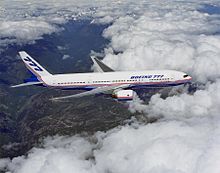
Major assembly of the first aircraft began on January 4, 1993. On April 9, 1994, the first 777, number WA001, was rolled out in a series of 15 ceremonies held during the day to accommodate the 100,000 invited guests. The first flight took place on June 12, 1994, under the command of chief test pilot John E. Cashman. This marked the start of an 11-month flight test program that was more extensive than testing for any previous Boeing model. Nine aircraft fitted with General Electric, Pratt & Whitney, and Rolls-Royce engines were flight tested at locations ranging from the desert airfield at Edwards Air Force Base in California to frigid conditions in Alaska, mainly Fairbanks International Airport. To satisfy ETOPS requirements, eight 180-minute single-engine test flights were performed. The first aircraft built was used by Boeing's nondestructive testing campaign from 1994 to 1996, and provided data for the -200ER and -300 programs.
At the successful conclusion of flight testing, the 777 was awarded simultaneous airworthiness certification by the US Federal Aviation Administration (FAA) and European Joint Aviation Authorities (JAA) on April 19, 1995.
Entry into service

Boeing delivered the first 777 to United Airlines on May 15, 1995. The FAA awarded 180-minute ETOPS clearance ("ETOPS-180") for the Pratt & Whitney PW4084-engined aircraft on May 30, 1995, making it the first airliner to carry an ETOPS-180 rating at its entry into service. The first commercial flight took place on June 7, 1995, from London Heathrow Airport to Dulles International Airport near Washington, D.C. Longer ETOPS clearance of 207 minutes was approved in October 1996.
On November 12, 1995, Boeing delivered the first model with General Electric GE90-77B engines to British Airways, which entered service five days later. Initial service was affected by gearbox bearing wear issues, which caused British Airways to temporarily withdraw its 777 fleet from transatlantic service in 1997, returning to full service later that year. General Electric subsequently announced engine upgrades.
The first Rolls-Royce Trent 877-powered aircraft was delivered to Thai Airways International on March 31, 1996, completing the introduction of the three powerplants initially developed for the airliner. Each engine-aircraft combination had secured ETOPS-180 certification from its entry into service. By June 1997, orders for the 777 numbered 323 from 25 airlines, including launch customers that had ordered additional aircraft. Operations performance data established the consistent capabilities of the twinjet over long-haul transoceanic routes, leading to additional sales. By 1998, the 777 fleet had approached 900,000 flight hours. Boeing states that the 777 fleet has a dispatch reliability (rate of departure from the gate with no more than 15 minutes delay due to technical issues) above 99 percent.
Improvement and stretching: -200ER/-300
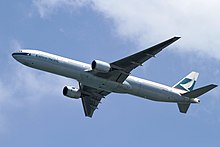
After the baseline model, the 777-200, Boeing developed an increased gross weight variant with greater range and payload capability. Initially named 777-200IGW, the 777-200ER first flew on October 7, 1996, received FAA and JAA certification on January 17, 1997, and entered service with British Airways on February 9, 1997. Offering greater long-haul performance, the variant became the most widely ordered version of the aircraft through the early 2000s. On April 2, 1997, a Malaysia Airlines -200ER named "Super Ranger" broke the great circle "distance without landing" record for an airliner by flying eastward from Boeing Field, Seattle to Kuala Lumpur, a distance of 10,823 nautical miles (20,044 km; 12,455 mi), in 21 hours and 23 minutes.
Following the introduction of the -200ER, Boeing turned its attention to a stretched version of the baseline model. On October 16, 1997, the 777-300 made its first flight. At 242.4 ft (73.9 m) in length, the -300 became the longest airliner yet produced (until the A340-600), and had a 20 percent greater overall capacity than the standard length model. The -300 was awarded type certification simultaneously from the FAA and JAA on May 4, 1998, and entered service with launch customer Cathay Pacific on May 27, 1998.
The first generation of Boeing 777 models, the -200, -200ER, and -300 have since been known collectively as Boeing 777 Classics. These three early 777 variants had three engine options ranging from 77,200 to 98,000 lbf (343 to 436 kN): General Electric GE90, Pratt & Whitney PW4000, or Rolls-Royce Trent 800.
Production
The production process included substantial international content, an unprecedented level of global subcontracting for a Boeing jetliner, later exceeded by the 787. International contributors included Mitsubishi Heavy Industries and Kawasaki Heavy Industries (fuselage panels), Fuji Heavy Industries, Ltd. (center wing section), Hawker de Havilland (elevators), and Aerospace Technologies of Australia (rudder). An agreement between Boeing and the Japan Aircraft Development Corporation, representing Japanese aerospace contractors, made the latter risk-sharing partners for 20 percent of the entire development program.

To accommodate production of its new airliner, Boeing doubled the size of the Everett factory at the cost of nearly US$1.5 billion (~$2.86 billion in 2023) to provide space for two new assembly lines. New production methods were developed, including a turn machine that could rotate fuselage subassemblies 180 degrees, giving workers access to upper body sections. By the start of production in 1993, the program had amassed 118 firm orders, with options for 95 more from 10 airlines. Total investment in the program was estimated at over $4 billion from Boeing, with an additional $2 billion from suppliers.
Initially second to the 747 as Boeing's most profitable jetliner, the 777 became the company's most lucrative model in the 2000s. An analyst established the 777 program, assuming Boeing has fully recouped the plane's development costs, may account for $400 million of the company's pretax earnings in 2000, $50 million more than the 747. By 2004, the airliner accounted for the bulk of wide-body revenues for Boeing Commercial Airplanes. In 2007, orders for second-generation 777 models approached 350 aircraft, and in November of that year, Boeing announced that all production slots were sold out to 2012. The program backlog of 356 orders was valued at $95 billion at list prices in 2008.
In 2010, Boeing announced plans to increase production from 5 aircraft per month to 7 aircraft per month by mid-2011, and 8.3 per month by early 2013. In November 2011, assembly of the 1,000th 777, a -300ER, began when it took 49 days to fully assemble one of these variants. The aircraft in question was built for Emirates airline, and rolled out of the production facility in March 2012. By the mid-2010s, the 777 had become prevalent on the longest flights internationally and had become the most widely used airliner for transpacific routes, with variants of the type operating over half of all scheduled flights and with the majority of transpacific carriers. By April 2014, with cumulative sales surpassing those of the 747, the 777 became the best-selling wide-body airliner; at existing production rates, the aircraft was on track to become the most-delivered wide-body airliner by mid-2016.
By February 2015, the backlog of undelivered 777s totaled 278 aircraft, equivalent to nearly three years at the then production rate of 8.3 aircraft per month, causing Boeing to ponder the 2018–2020 time frame. In January 2016, Boeing confirmed plans to reduce the production rate of the 777 family from 8.3 per month to 7 per month in 2017 to help close the production gap between the 777 and 777X due to a lack of new orders. In August 2017, Boeing was scheduled to drop 777 production again to five per month. In 2018, assembling test 777-9 aircraft was expected to lower output to an effective rate of 5.5 per month. In March 2018, as previously predicted, the 777 overtook the 747 as the world's most produced wide body aircraft. Due to the impact of the COVID-19 pandemic on aviation, demand for new jets fell in 2020 and Boeing further reduced monthly 777 production from five to two aircraft.
Second generation (777-X): -300ER/-200LR/F
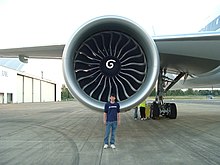
From the program's start, Boeing had considered building ultra-long-range variants. Early plans centered on a 777-100X proposal, a shortened variant of the -200 with reduced weight and increased range, similar to the 747SP. However, the -100X would have carried fewer passengers than the -200 while having similar operating costs, leading to a higher cost per seat. By the late 1990s, design plans shifted to longer-range versions of existing models.
In March 1997, the Boeing board approved the 777-200X/300X specifications: 298 passengers in three classes over 8,600 nmi (15,900 km; 9,900 mi) for the 200X and 6,600 nmi (12,200 km; 7,600 mi) with 355 passengers in a tri-class layout for the 300X, with design freeze planned in May 1998, 200X certification in August 2000, and introduction in September and in January 2001 for the 300X. The 4.5 ft (1.37 m) wider wing was to be strengthened and the fuel capacity enlarged, and it was to be powered by simple derivatives with similar fans. GE was proposing a 102,000 lbf (454 kN) GE90-102B, while P&W offered its 98,000 lbf (436 kN) PW4098 and R-R was proposing a 98,000 lbf (437 kN) Trent 8100. Rolls-Royce was also studying a Trent 8102 over 100,000 lbf (445 kN). Boeing was also studying a semi-levered, articulated main gear to help the take-off rotation of the proposed -300X, with its higher 715,600 lb (324,600 kg) MTOW. By January 1999, its MTOW grew to 750,700 lb (340,500 kg), and thrust requirements increased to 110,000–114,000 lbf (490–510 kN).
A more powerful engine in the thrust class of 100,000 lbf (440 kN) was required, leading to talks between Boeing and engine manufacturers. General Electric offered to develop the GE90-115B engine, while Rolls-Royce proposed developing the Trent 8104 engine. In 1999, Boeing announced an agreement with General Electric, beating out rival proposals. Under the deal with General Electric, Boeing agreed to only offer GE90 engines on new 777 versions.

On February 29, 2000, Boeing launched its next-generation twinjet program, initially called 777-X, and began issuing offers to airlines. Development was slowed by an industry downturn during the early 2000s. The first model to emerge from the program, the 777-300ER, was launched with an order for ten aircraft from Air France, along with additional commitments. On February 24, 2003, the -300ER made its first flight, and the FAA and EASA (European Aviation Safety Agency, successor to the JAA) certified the model on March 16, 2004. The first delivery to Air France took place on April 29, 2004. The -300ER, which combined the -300's added capacity with the -200ER's range, became the top-selling 777 variant in the late 2000s, benefitting as airlines replaced comparable four-engine models with twinjets for their lower operating costs.
The second long-range model, the 777-200LR, rolled out on February 15, 2005, and completed its first flight on March 8, 2005. The -200LR was certified by both the FAA and EASA on February 2, 2006, and the first delivery to Pakistan International Airlines occurred on February 26, 2006. On November 10, 2005, the first -200LR set a record for the longest non-stop flight of a passenger airliner by flying 11,664 nautical miles (21,602 km; 13,423 mi) eastward from Hong Kong to London. Lasting 22 hours and 42 minutes, the flight surpassed the -200LR's standard design range and was logged in the Guinness World Records.
The production freighter model, the 777F, rolled out on May 23, 2008. The maiden flight of the 777F, which used the structural design and engine specifications of the -200LR along with fuel tanks derived from the -300ER, occurred on July 14, 2008. FAA and EASA type certification for the freighter was received on February 6, 2009, and the first delivery to launch customer Air France took place on February 19, 2009.
By the late 2000s, the 777 was facing increased potential competition from Airbus' planned A350 XWB and internally from proposed 787 series, both airliners that offer fuel efficiency improvements. As a consequence, the 777-300ER received engine and aerodynamics improvement packages for reduced drag and weight. In 2010, the variant further received a 5,000 lb (2,300 kg) maximum zero-fuel weight increase, equivalent to a higher payload of 20–25 passengers; its GE90-115B1 engines received a 1–2.5 percent thrust enhancement for increased takeoff weights at higher-altitude airports. Through these improvements, the 777 remains the largest twin-engine jetliner in the world.
In 2011, the 787 Dreamliner entered service, the completed first stage a.k.a. the Yellowstone-2 (Y2) of a replacement aircraft initiative called the Boeing Yellowstone Project, which would replace large variants of the 767 (300/300ER/400) but also small variants of the 777 (-200/200ER/200LR). While the larger variants of the 777 (-300/300ER) as well as the 747 could eventually be replaced by a new generation aircraft, the Yellowstone-3 (Y3), which would draw upon technologies from the 787 Dreamliner (Y2). More changes were targeted for late 2012, including possible extension of the wingspan, along with other major changes, including a composite wing, a new generation engine, and different fuselage lengths. Emirates was reportedly working closely with Boeing on the project, in conjunction with being a potential launch customer for the new 777 generation. Among customers for the aircraft during this period, China Airlines ordered ten 777-300ER aircraft to replace 747-400s on long-haul transpacific routes (with the first of those aircraft entering service in 2015), noting that the 777-300ER's per seat cost is about 20% lower than the 747's costs (varying due to fuel prices).
Improvement packages
In tandem with the development of the third generation Boeing 777X, Boeing worked with General Electric to offer a 2% improvement in fuel efficiency to in-production 777-300ER aircraft. General Electric improved the fan module and the high-pressure compressor stage-1 blisk in the GE-90-115 turbofan, as well as reduced clearances between the tips of the turbine blades and the shroud during cruise. These improvements, of which the latter is the most important and was derived from work to develop the 787, were stated by GE to lower fuel burn by 0.5%. Boeing's wing modifications were intended to deliver the remainder. Boeing stated that every 1% improvement in the 777-300ER's fuel burn translates into being able to fly the aircraft another 75 nmi (139 km; 86 mi) on the same load of fuel, or add ten passengers or 2,400 lb (1,100 kg) of cargo to a "load limited" flight.
In March 2015, additional details of the "improvement package" were unveiled. The 777-300ER was to shed 1,800 lb (820 kg) by replacing the fuselage crown with tie rods and composite integration panels, similar to those used on the 787. The new flight control software would eliminate the need for the tail skid by keeping the tail off the runway surface regardless of the extent to which pilots command the elevators. Boeing was also redesigning the inboard flap fairings to reduce drag by reducing pressure on the underside of the wing. The outboard raked wingtip was to have a divergent trailing edge, described as a "poor man's airfoil" by Boeing; this was originally developed for the McDonnell Douglas MD-12 project. Another change involved elevator trim bias. These changes were to increase fuel efficiency and allow airlines to add 14 additional seats to the airplane, increasing per seat fuel efficiency by 5%.
Mindful of the long time required to bring the 777X to the market, Boeing continued to develop improvement packages which improve fuel efficiency, as well as lower prices for the existing product. In January 2015, United Airlines ordered ten 777-300ERs, normally selling for around $150 million per aircraft, were purchased for $130 million each, a discount to bridge the production gap to the 777X. In 2019, the list price for the -200ER was $306.6 million, the -200LR: $346.9 million, the -300ER: $375.5 million and 777F: $352.3 million. The -200ER is the only Classic variant listed.
Third generation (777X): -8/-8F/-9

In November 2013, with orders and commitments totaling 259 aircraft from Lufthansa, Emirates, Qatar Airways, and Etihad Airways, Boeing formally launched the 777X program, the third generation of the 777, with two models: the 777-8 and 777-9. The 777-9 is a further stretched variant with a capacity of over 400 passengers and a range of over 8,200 nmi (15,200 km; 9,400 mi), whereas the 777-8 is slated to seat approximately 350 passengers and have a range of over 9,300 nmi (17,200 km; 10,700 mi). Both models are to be equipped with new generation GE9X engines and feature new composite wings with folding wingtips. The first member of the 777X family was projected to enter service in 2020 at the time of the program announcement. The roll-out of the prototype 777X, a 777-9 model, occurred on March 13, 2019. The 777-9 first flew on January 25, 2020, with deliveries initially forecast for 2022 or 2023 and later delayed to 2025.
Design

Boeing introduced a number of advanced technologies with the 777 design, including fully digital fly-by-wire controls, fully software-configurable avionics, Honeywell LCD glass cockpit flight displays, and the first use of a fiber optic avionics network on a commercial airliner. Boeing made use of work done on the cancelled Boeing 7J7 regional jet, which utilized similar versions of the chosen technologies. In 2003, Boeing began offering the option of cockpit electronic flight bag computer displays. In 2013, Boeing announced that the upgraded 777X models would incorporate airframe, systems, and interior technologies from the 787.
Fly-by-wire
In designing the 777 as its first fly-by-wire commercial aircraft, Boeing decided to retain conventional control yokes rather than change to sidestick controllers as used in many fly-by-wire fighter aircraft and in many Airbus airliners. Along with traditional yoke and rudder controls, the cockpit features a simplified layout that retains similarities to previous Boeing models. The fly-by-wire system also incorporates flight envelope protection, a system that guides pilot inputs within a computer-calculated framework of operating parameters, acting to prevent stalls, overspeeds, and excessively stressful maneuvers. This system can be overridden by the pilot if deemed necessary. The fly-by-wire system is supplemented by mechanical backup.
Airframe and systems

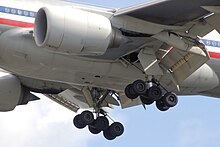
| External videos | |
|---|---|
The airframe incorporates the use of composite materials, accounting for nine percent of the original structural weight, while the third-generation models, the 777-8 and 777-9, feature more composite parts. Composite components include the cabin floor and rudder, with the 777 being the first Boeing airliner to use composite materials for both the horizontal and vertical stabilizers (empennage). The main fuselage cross-section is fully circular, and tapers rearward into a blade-shaped tail cone with a port-facing auxiliary power unit.
The wings on the 777 feature a supercritical airfoil design that is swept back at 31.6 degrees and optimized for cruising at Mach 0.83 (revised after flight tests up to Mach 0.84). The wings are designed with increased thickness and a longer span than previous airliners, resulting in greater payload and range, improved takeoff performance, and a higher cruising altitude. The wings also serve as fuel storage, with longer-range models able to carry up to 47,890 US gallons (181,300 L) of fuel. This capacity allows the 777-200LR to operate ultra-long-distance, trans-polar routes such as Toronto to Hong Kong. In 2013, a new wing made of composite materials was introduced for the upgraded 777X, with a wider span and design features based on the 787's wings.
Folding wingtips, 21 feet (6.40 m) long, were offered when the 777 was first launched, to appeal to airlines who might use gates made to accommodate smaller aircraft, but no airline purchased this option. Folding wingtips reemerged as a design feature at the announcement of the upgraded 777X in 2013. Smaller folding wingtips of 11 feet (3.35 m) in length will allow 777X models to use the same airport gates and taxiways as earlier 777s. These smaller folding wingtips are less complex than those proposed for earlier 777s, and internally only affect the wiring needed for wingtip lights.
The aircraft features the largest landing gear and the biggest tires ever used in a commercial jetliner. The six-wheel bogies are designed to spread the load of the aircraft over a wide area without requiring an additional centerline gear. This helps reduce weight and simplifies the aircraft's braking and hydraulic systems. Each tire of a 777-300ER six-wheel main landing gear can carry a load of 59,490 lb (26,980 kg), which is heavier than other wide-bodies such as the 747-400. The aircraft has triple redundant hydraulic systems with only one system required for landing. A ram air turbine—a small retractable device which can provide emergency power—is also fitted in the wing root fairing.
Interior

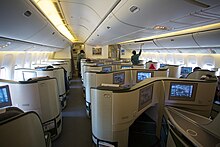
The original 777 interior, also known as the Boeing Signature Interior, features curved panels, larger overhead bins, and indirect lighting. Seating options range from four to six–abreast in first class up to ten–abreast in economy. The 777's windows were the largest of any current commercial airliner until the 787, and measure 15 by 10 inches (380 by 250 mm) for all models outside the 777-8 and -9. The cabin also features "Flexibility Zones", which entails deliberate placement of water, electrical, pneumatic, and other connection points throughout the interior space, allowing airlines to move seats, galleys, and lavatories quickly and more easily when adjusting cabin arrangements. Several aircraft have also been fitted with VIP interiors for non-airline use. Boeing designed a hydraulically damped toilet seat cover hinge that closes slowly.
In February 2003, Boeing introduced overhead crew rests as an option on the 777. Located above the main cabin and connected via staircases, the forward flight crew rest contains two seats and two bunks, while the aft cabin crew rest features multiple bunks. The Signature Interior has since been adapted for other Boeing wide-body and narrow-body aircraft, including 737NG, 747-400, 757-300, and newer 767 models, including all 767-400ER models. The 747-8 and 767-400ER have also adopted the larger, more rounded windows of the original 777.
In July 2011, Flight International reported that Boeing was considering replacing the Signature Interior on the 777 with a new interior similar to that on the 787, as part of a move towards a "common cabin experience" across all Boeing platforms. With the launch of the 777X in 2013, Boeing confirmed that the aircraft would be receiving a new interior featuring 787 cabin elements and larger windows. Further details released in 2014 included re-sculpted cabin sidewalls for greater interior room, noise-damping technology, and higher cabin humidity.
Air France has a 777-300ER sub-fleet with 472 seats each, more than any other international 777, to achieve a cost per available seat kilometer (CASK) around €.05, similar to Level's 314-seat Airbus A330-200, its benchmark for low-cost, long-haul. Competing on similar French overseas departments destinations, Air Caraïbes has 389 seats on the A350-900 and 429 on the -1000. French Bee's is even more dense with its 411 seats A350-900, due to 10-abreast economy seating, reaching a €.04 CASK according to Air France, and lower again with its 480 seats on the -1000.
Engines
The initial 777 models (consisting of the 777-200, 777-200ER, 777-300) were launched with propulsion options from three manufacturers, GE Aviation, Pratt & Whitney, and Rolls-Royce, giving the airlines their choice of engines from competing firms. Each manufacturer agreed to develop an engine in the 77,200–98,000 lbf (343–436 kN) of thrust class for the world's largest twinjet, resulting in the General Electric GE90, Pratt & Whitney PW4000, or Rolls-Royce Trent 800 engines. The Trent 800 is the lightest of the three powerplants as it weighs 13,400 lb (6.078 t) dry, while the GE90 is 17,400 lb (7.89 t), and the PW4000 is 16,260 lb (7.38 t).


